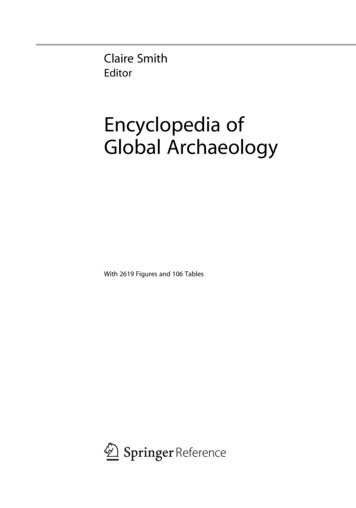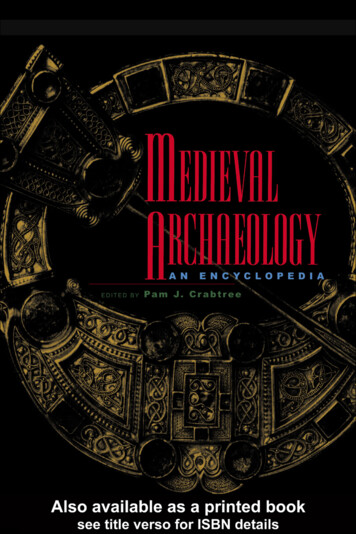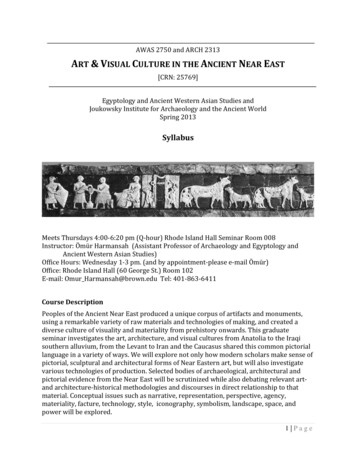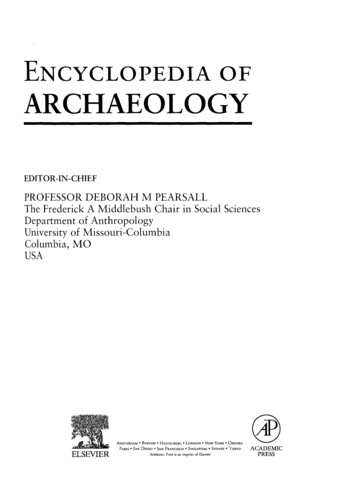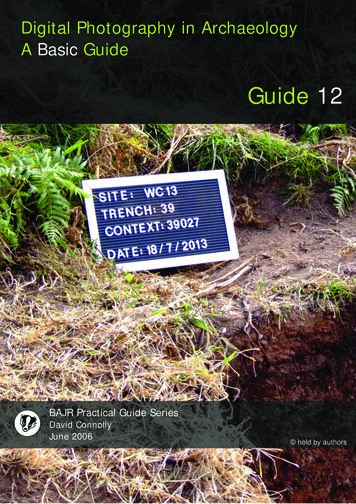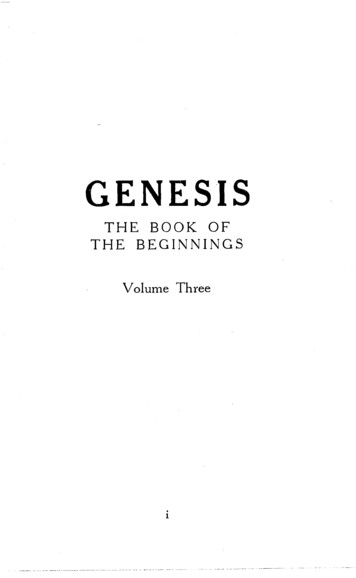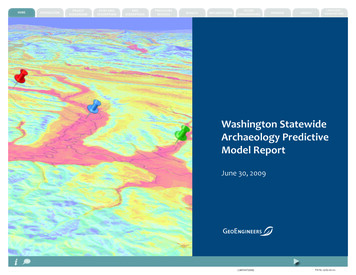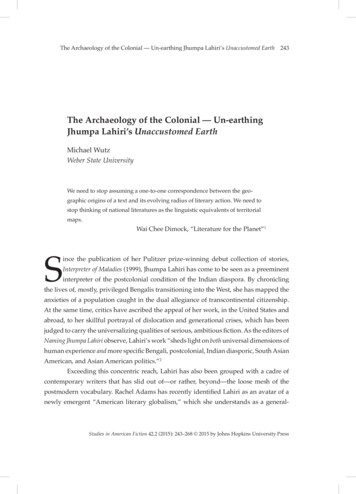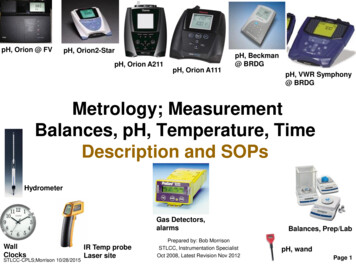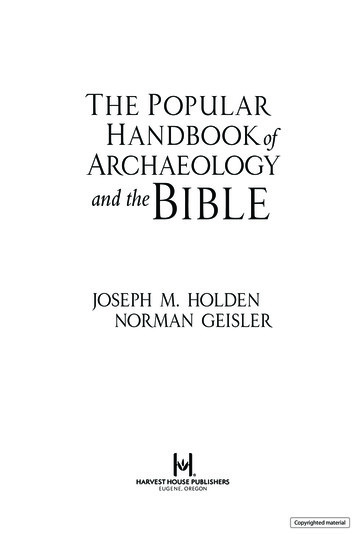
Transcription
Copyrighted material
Unless otherwise indicated, all Scripture quotations are from the New American Standard Bible , 1960, 1962, 1963,1968, 1971, 1972, 1973, 1975, 1977, 1995 by The Lockman Foundation. Used by permission. (www.Lockman.org)Verses marked niv are from the Holy Bible, New International Version , NIV . Copyright 1973, 1978, 1984, 2011,by Biblica, Inc. Used by permission of Zondervan. All rights reserved worldwide. www.zondervan.comVerses marked esv are from The ESV Bible (The Holy Bible, English Standard Version ), copyright 2001 by Crossway, a publishing ministry of Good News Publishers. Used by permission. All rights reserved.Verses marked nkjv are taken from the New King James Version. Copyright 1982 by Thomas Nelson, Inc. Usedby permission. All rights reserved.Verses marked kjv are taken from the King James Version of the Bible.Emphasis (italics) in Scripture quotations has been added by the authors.Cover by Dugan Design Group, Bloomington, MinnesotaCover photos Helga, Martin Bache / AlamyAll uncredited interior photos are Joseph M. Holden, 2013.THE POPULAR HANDBOOK OF ARCHAEOLOGY AND THE BIBLECopyright 2013 by Norman Geisler and Joseph M. HoldenPublished by Harvest House PublishersEugene, Oregon 97402www.harvesthousepublishers.comLibrary of Congress Cataloging-in-Publication DataThe popular handbook of archaeology and the Bible / Norman Geisler and Joseph M. Holden.pages cmIncludes bibliographical references.ISBN 978-0-7369-4485-4 (pbk.)1. Bible—Evidences, authority, etc. 2. Bible—Antiquities. I. Geisler, Norman L.BS480.P645 2013220.9'3—dc232012041424All rights reserved. No part of this publication may be reproduced, stored in a retrieval system, or transmitted in anyform or by any means—electronic, mechanical, digital, photocopy, recording, or any other—except for brief quotations in printed reviews, without the prior permission of the publisher.Copyrighted material
To my two sons, David and Ian,because of their youthful sense of adventureand zeal for archaeology and the Bible.—Joseph HoldenTo my first teacher of archaeology,who inspired me in the field,the late Dr. Charles Shaw.—Norman GeislerCopyrighted material
AcknowledgmentsIn a work like this one it is difficult to give credit to all involved, sinceso many contributed in their unique ways. Without them this book wouldnever have come to fruition. It is our pleasure to acknowledge the staff andadministration of our own Veritas Evangelical Seminary for their patienceand encouragement throughout the writing of the book. Their supportmakes this work a team effort.However, we would like to give a special word of appreciation toAndrew W. Pitts and Dr. H. Wayne House, whose research assistance hasmade the book better in every way.Further, without the technical assistance of Sam Capshaw and the skill,professionalism, flexibility, and labor of Bob Hawkins Jr. and Steve Millerof Harvest House Publishers, this book would never have made it to thepress. A special thanks also to Paul Gossard for his skillful editing and hisattentiveness to the needs of the reader.Most of all, we would like to thank our Lord Jesus Christ for theunadulterated privilege He has given us to share the unsearchable richesof Christ with our generation. We sincerely hope this book will glorifyHim by being a small step toward casting some light on the historical reality behind His unconditional love for mankind.Copyrighted material
ContentsList of Key Charts and Tables . . . . . . . . . . . . . . . . . . . . . . . . . . . . . . . . 11Foreword by Dr. Walter C. Kaiser Jr. . . . . . . . . . . . . . . . . . . . . . . . . . . . . 13Preface: Facts That Support Faith . . . . . . . . . . . . . . . . . . . . . . . . . . . . . . 15Part One: The Reliability of Old Testament ManuscriptsIntroduction. . . . . . . . . . . . . . . . . . . . . . . . . . . . . . . . . . . . . . . . . . . . . . 191. The Masoretes and the Samaritans . . . . . . . . . . . . . . . . . . . . . . . . . . . . . 212. The Dead Sea Scrolls and the Silver Scrolls . . . . . . . . . . . . . . . . . . . . . . . 333. The Transmission of the Old Testament—Summary. . . . . . . . . . . . . . . . 49Part Two: The Reliability of Old Testament HistoryIntroduction. . . . . . . . . . . . . . . . . . . . . . . . . . . . . . . . . . . . . . . . . . . . . . 554. Moses, the Pentateuch, and the Major Prophets . . . . . . . . . . . . . . . . . . . 575. Alleged Errors vs. Archaeological Discoveries . . . . . . . . . . . . . . . . . . . . . 776. The Canon of the Old Testament . . . . . . . . . . . . . . . . . . . . . . . . . . . . . . 87Part Three: The Reliability of New Testament ManuscriptsIntroduction. . . . . . . . . . . . . . . . . . . . . . . . . . . . . . . . . . . . . . . . . . . . . . 977. The Transmission of the New Testament. . . . . . . . . . . . . . . . . . . . . . . . . 998. The Manuscripts of the New Testament . . . . . . . . . . . . . . . . . . . . . . . . 1119. The Accuracy of the New Testament Manuscripts. . . . . . . . . . . . . . . . . . 127Part Four: The Reliability of New Testament HistoryIntroduction. . . . . . . . . . . . . . . . . . . . . . . . . . . . . . . . . . . . . . . . . . . . . . 13110. Historicity of the New Testament. . . . . . . . . . . . . . . . . . . . . . . . . . . . . . 13311. Responding to Recent Criticisms of the Gospels. . . . . . . . . . . . . . . . . . . 14312. Criticisms of the Resurrection Accounts and the Epistles . . . . . . . . . . . . 15913. The Canon of the New Testament. . . . . . . . . . . . . . . . . . . . . . . . . . . . . . 171Part Five: Introduction to ArchaeologyIntroduction. . . . . . . . . . . . . . . . . . . . . . . . . . . . . . . . . . . . . . . . . . . . . . 17714. Archaeology and the Bible. . . . . . . . . . . . . . . . . . . . . . . . . . . . . . . . . . . . 18115. Keys to Understanding Archaeology in Biblical Lands . . . . . . . . . . . . . . 189Copyrighted material
Part Six: Archaeology of the Old TestamentIntroduction. . . . . . . . . . . . . . . . . . . . . . . . . . . . . . . . . . . . . . . . . . . . . . 19916. Creation and Flood, the Tower of Babel, and the Cities of the Plain . . . 20317. Exodus and Conquest. . . . . . . . . . . . . . . . . . . . . . . . . . . . . . . . . . . . . . . 22118. The Amarna Letters, the Hittites, and the City of Megiddo. . . . . . . . . . 23919. King David and His Dynasty . . . . . . . . . . . . . . . . . . . . . . . . . . . . . . . . 24920. Nebuchadnezzar II and the Persian Kings. . . . . . . . . . . . . . . . . . . . . . . 26921. Old Testament Persons Confirmed by Archaeology . . . . . . . . . . . . . . . 283Part Seven: Archaeology of the New TestamentIntroduction. . . . . . . . . . . . . . . . . . . . . . . . . . . . . . . . . . . . . . . . . . . . . . 29122. Jesus and Other New Testament Persons in Non-Christian Sources . . . 29523. Jesus and Archaeological Sources. . . . . . . . . . . . . . . . . . . . . . . . . . . . . . 30724. The Temple Mount. . . . . . . . . . . . . . . . . . . . . . . . . . . . . . . . . . . . . . . . 32325. Herod, Pilate, and Caiaphas. . . . . . . . . . . . . . . . . . . . . . . . . . . . . . . . . 34326. More Fascinating Finds Relating to the New Testament . . . . . . . . . . . . . 351Glossary of Key Terms. . . . . . . . . . . . . . . . . . . . . . . . . . . . . . . . . . . . . . 369Appendix A: New Testament Manuscript Papyri:A Descriptive List. . . . . . . . . . . . . . . . . . . . . . . . . . . . . . . . . . . . . . . . . 373Appendix B: Ascertaining the Geography ofthe Cities of the Plain: 40 Points. . . . . . . . . . . . . . . . . . . . . . . . . . . . . . 383Appendix C: Expert Witness Opinions Regardingthe Authenticity of the James Ossuary. . . . . . . . . . . . . . . . . . . . . . . . . . 389Notes . . . . . . . . . . . . . . . . . . . . . . . . . . . . . . . . . . . . . . . . . . . . . . . . . . 395Select Bibliography. . . . . . . . . . . . . . . . . . . . . . . . . . . . . . . . . . . . . . . . 409Index. . . . . . . . . . . . . . . . . . . . . . . . . . . . . . . . . . . . . . . . . . . . . . . . . . . . 413Copyrighted material
List of Key Charts and TablesOld Testament Manuscripts. . . . . . . . . . . . . . . . . . . . . . . . . . . . . . . . . . . . . . . . . . . 52The Historical Reliability of Genesis and Exodus:Summary of Major Points . . . . . . . . . . . . . . . . . . . . . . . . . . . . . . . . . . . . . . . . . 66Archaeological Discoveries Supporting the Reliability ofOld Testament History . . . . . . . . . . . . . . . . . . . . . . . . . . . . . . . . . . . . . . . . . . . 81New Testament Manuscript Distributionby Century and Manuscript Type . . . . . . . . . . . . . . . . . . . . . . . . . . . . . . . . . . . 105Papyrus and Codex Manuscripts of the New Testament: Summary Listingof Key Early Witnesses to the New Testament’s Reliability. . . . . . . . . . . . . . . . 118Early Citations of the New Testament. . . . . . . . . . . . . . . . . . . . . . . . . . . . . . . . . . . 125New Testament Manuscripts Compared to Other Ancient Sources. . . . . . . . . . . . . 129Non-Christian Sources Within 150 Years of Jesus. . . . . . . . . . . . . . . . . . . . . . . . . . . 141Order of Resurrection Events and Evidence They Provide. . . . . . . . . . . . . . . . . . . . 159The New Testament Canon During the First Four Centuries. . . . . . . . . . . . . . . . . . 175Archaeological Ages and Israel. . . . . . . . . . . . . . . . . . . . . . . . . . . . . . . . . . . . . . . . . 191Understanding Archaeological Terms. . . . . . . . . . . . . . . . . . . . . . . . . . . . . . . . . . . . 193Differences in Mesopotamian and Genesis Flood Accounts. . . . . . . . . . . . . . . . . . . 210Which Location of Sodom Accountsfor the Biblical Geography of Genesis 13:1-12?. . . . . . . . . . . . . . . . . . . . . . . . . . 219The Book of Exodus and the Ipuwer Papyrus: Comparison. . . . . . . . . . . . . . . . . . . 223Scientific and Factual Errors in the Red Algae/Red Mud Theoryof the Exodus Plague of Blood and Ensuing Plagues . . . . . . . . . . . . . . . . . . . . 226Seal Impressions of People in the Old Testament. . . . . . . . . . . . . . . . . . . . . . . . . . . 261Old Testament Persons Confirmed by Archaeology. . . . . . . . . . . . . . . . . . . . . . . . . 283New Testament Persons Cited in Ancient Non-Christian Sources. . . . . . . . . . . . . 303More Archaeological Discoveries Supporting New Testament Reliability. . . . . . . . . 359New Testament Manuscript Papyri: A Descriptive List . . . . . . . . . . . . . . . . . . . . . . 373Ascertaining the Geography of the Cities of the Plain: 40 Points. . . . . . . . . . . . . . . 383Expert Witness Opinions Regarding the Authenticity of the James Ossuary . . . . . . 38911Copyrighted material
Copyrighted material
Forewordby Dr. Walter C. Kaiser Jr.Among the newer generation of biblical scholars there is a strong but unnecessarysense of skepticism about the historical claims of the Bible. These leaders in thefield call themselves “revisionists,” but others regard them as “minimalists” or even the“new nihilists.” They claim “it is no longer possible to write a history about any ancientperson or event, much less about a biblical happening at all”!Fortunately, this group is still not in the majority of biblical scholars by a long shot,but the corrosive effects of their persistent denials are arriving in the culture at the sametime as the postmodern agenda is being offered as a view for all reality. Aspects of someof their reasoning and arguments have sifted down into all spheres of society—yes, evenat times to those in the believing community!Such a postmodern agenda includes some of the following traits: 1) a revolt againstall authority, 2) a distrust of all that is universal, 3) the premise that “social constructs” setthe bounds for all knowledge, 4) the belief that all truth is relative, 5) the idea that there isno “meaning” except the meaning each of us creates for ourselves, and 6) the notion thatone ideology is just as appropriate as another; in fact, the more radical the idea, the morelikely it will be accorded a gracious hearing and applauded by innovators in the culture.When such an agenda is used to interpret biblical texts, the sense of the postmodernargument is that those texts should be “liberated from historical consideration.” Therefore, it is against such an “antihistorical” movement that this volume has, in part, beenconceived and written. The case for the reliability of the persons and events of the Biblebecomes more needed and more necessary each day as the newer generation’s antibiblical thesis takes a greater hold on the hearts and minds of its members.Meanwhile, the evidence for the truthfulness and historicity of the Bible continuesto mount up as never before. Just when skepticism seems to be making the most noise,we are being flooded with an overwhelming amount of real, hard evidences that demanda verdict opposite to what skeptics, revisionists, minimalists, and deconstructionists areclamoring for in their current worldviews and life views. Never has any previous generation seen the amount and significance of evidences that are now available to us today.13Copyrighted material
14The Popular Handbook of Archaeology and the BibleFor all too many who have been touched by the acids of these negative forms ofmodernity, this book will seem “like honey from the rock,” for it will lay out the opposite case in a most convincing and kind way. In a most delightful and truly readable fashion, one convincing argument after another will be set forth until the whole case forthe reliability of the Bible and the truthfulness of its history strikes home to the readerwith thunderous effects. There will be no need for anyone to be overwhelmed by current skepticism, for the biblical case is now weighted extremely heavily in favor of thosewho hold to the historical accuracy of the Bible. Enjoy this rare tour through the manuscripts, history, archaeology, and facts of the Scriptures.Walter C. Kaiser Jr.President Emeritus,Gordon-Conwell Theological SeminaryCopyrighted material
PrefaceFacts That Support FaithIn the twenty-first century, the previous century’s debate over the historical reliabil ity of the Bible has taken on a new face and has gained fresh momentum in light ofrecent discoveries unearthed through archaeological excavation of the Holy Land. Manyof these findings relate either directly or indirectly to the people, places, events, customs,and beliefs recorded in the Bible. As a result, the assertion by critical scholars that theBible’s historical descriptions are a product of human invention can no longer be maintained without facing strong counterarguments. Because of these finds, many modernscholars have revisited the archaeological and historical data with fresh insight into thereliability question. However, much of this valuable material often languishes in thehalls of academia, leaving the layperson unaware of the immense body of archaeological information at their disposal.Over the years, it has been our privilege to teach apologetics and theology coursesat various undergraduate and graduate schools and conferences throughout the world.In addition, we have had the opportunity to travel extensively throughout the biblicallands, including Israel, Egypt, Jordan, Turkey, Greece, and Italy, as well as participatingin archaeological excavation. In the process of communicating this material in the classroom, it is common to draw upon archaeological and historical data in order to demonstrate the reliability of the Bible. In doing this, we have seen the need to share withthe body of Christ the accumulating data that reinforces our confidence in the historical narratives throughout the Scriptures. For as C.S. Lewis once wrote,To be ignorant and simple now, not to be able to meet the enemieson their own ground, would be to throw down our weapons, and tobetray our uneducated brethren who have, under God, no defense butus against the intellectual attacks of the heathen.As we have engaged many thousands of students and laypersons over the years in15Copyrighted material
16The Popular Handbook of Archaeology and the Bibledefense of the faith once for all committed to the saints, we have become increasinglyaware of the need for two important things: 1) to increase familiarity among the vastpublic of the basic archaeological evidence in support of the historical reliability of theBible, and 2) to expand awareness that facts (that is, history) and values (that is, doctrine and morals) are inextricably connected. It is from recognizing these needs that thisbook was born.This handbook offers a bridge that spans the gulf between higher academia and layChristian readers. It provides a means of educating and equipping them for participation in the reliability debate, which has for too long been relegated primarily to journal articles and scholarly discussions. Moreover, this work is intended to fill the gap inknowledge that exists within the church between our readers and the historical eventsrecorded in Scripture. This knowledge is crucial due to the role history plays—as theground from which doctrine and spiritual significance grow. Jesus understood the relationship between history and doctrine when He asked Nicodemus a crucial question: “IfI told you earthly things and you do not believe, how will you believe if I tell you heavenly things?” ( John 3:12).The time for compartmentalized thinking that separates history from faith is past,since it would align the church with the assumptions of negative higher criticism, whichsees no connection between the Jesus of history (whom they consider a nonsupernatural cynic sage who lived in the first-century) and the supernatural Christ of faith worshipped as God in churches around the world. The implications of unified thinkingbecome clear when we understand that the historical death of Christ on the cross is inextricably connected to one’s spiritual forgiveness of sin (Romans 4:25); and the historical creation of “male and female” in the beginning, to one’s view of marriage as existingonly between a man and a woman (Matthew 19:3-8). The crucial link between historyand doctrine cannot be broken lest we damage the apologetic structure supporting whyevangelical Christians cherish and rely on these very doctrines (Matthew 12:40).In view of these things, this archaeological handbook is offered as an introductorybeginning that confirms the “earthly things” contained in Scripture, in hope that thereader will become intimately acquainted with God’s redemptive history. After beingacquainted with these discoveries, the skeptical mind can much more easily give the benefit of the doubt to the “heavenly things” offered in Scripture. Our threefold hope andprayer is that the reader would1. recognize that the Christian worldview is holistic, viewing fact and value,faith and history, science and Christianity as complementary;2. become familiar with the apologetic support offered by the field ofarchaeology as it relates to confirming the historical statements in the Bible;andCopyrighted material
Preface173. comprehend the height, depth, and extent of God’s love for mankind asrevealed through His redemptive plan—a love that can be verified in realtime-space history.The content of the book is not meant to be an exhaustive treatment of manuscriptsor archaeological findings, nor a debate with the scholarly community. Rather, it is anintroductory summary for the beginner who desires an understanding of the more significant artifacts and manuscripts relating to the historical and textual reliability of theBible. Every attempt was made to offer commonly accepted facts concerning the dataand its relation to the Bible, leaving the “technical” discussions for the professionalarchaeologist. It is our hope that our readers will grow in their interest, passion, andknowledge of the fascinating field of archaeology and the Bible. If this book piques theinterest of our readers to further study, travel to Israel, or to get involved in archaeological excavation projects as a volunteer, it has been a success.Joseph M. Holden, PhDNorman L. Geisler, PhDCopyrighted material
Copyrighted material
Part OneThe Reliability of OldTestament Manuscripts The Bible is the most textually supported piece of literature from theancient world. This is because thousands of biblical manuscripts offerscholars the best opportunity (in numbers of manuscripts, accuracy ofthe transmitted text, and earliness of manuscript dates) to reconstructthe English editions of our Old and New Testaments. This part willexplore and describe the key manuscripts, the transmission, the canon,and the reliability of the Old Testament text. Part 3 will later offer a survey of New Testament manuscripts, transmission (copying process), andissues related to canonicity, and answer recent objections to the historical reliability of the New Testament text.In this current part we will consider the biblical manuscripts (a manuscript is an ancient handwritten copy of a part or whole of a biblicalbook or corpus) of the Old Testament and survey the two major textual traditions (a tradition is a group or family of manuscripts to whicha particular manuscript is related). One tradition is found mainly inthe Hebrew Masoretic Text. The second, and much earlier tradition, isassociated with the Dead Sea Scrolls discovered at Qumran beginningin 1947.19Copyrighted material
Copyrighted material
1The Masoretes and the SamaritansThe Hebrew text of the Old Testament was transmitted by a number of differentgroups within its history. The Sopherim (from Hebrew, meaning “scribes”) were Jewish scholars who preserved and copied the text from the fifth to the third centuries BC.The Zugoth (meaning “pairs” of scribes) were entrusted with this responsibility in thesecond and first centuries BC. By AD 200, the Tannaim (“repeaters” or “teachers”) tookover this task until about AD 500.*The MasoretesFrom this point, the group of medieval scribes primarily responsible for transmitting(and introducing vowels into) the Hebrew text upon which all editions of the HebrewBible were based for centuries were known as the Masoretes, or Masoretic scribes (frommasora, meaning “traditions”). Thus we call the text they produced the Masoretic Text.There were two somewhat independent schools of Masoretes: the Babylonian andthe Palestinian. The most famous Masoretes were the Jewish scholars living in Tiberias inGalilee in the late ninth and tenth centuries AD: Moses ben Asher (with his son Aaron),and Moses ben Naphtali. Though these two families are often considered to have formedseparate traditions of textual preservation, they represent only a single textual tradition.The devotion and care with which the scribes copied the text is seen in the consonantaltext—the pre-Masoretic text containing only consonants with no vowels. The versionspreserved by the two families respectively contained a mere nine linguistic differencesbetween them. The Ben Naphtali tradition eventually died out, while the Ben Asher tradition continued to flourish, representing the superior text.The Ben Asher text is the standard text for the Hebrew Bible today and is best* The work of the Tannaim can be found in the Midrash (“textual interpretation” of the Old Testament, a compilation oforal tradition), Tosefta (meaning “supplement” to the Mishnah, c. AD 240), and the Talmud (“instruction”), the latter ofwhich is divided into Mishnah (“repetitions”) and Gemara (“the matter to be learned”). The Talmud constitutes a commentary on the Mishnah—literally a commentary on a commentary. Comprising two collections of Talmudic literature—theBabylonian and the Jerusalem Talmud—the Talmud was slowly written between AD 450 and 650.21Copyrighted material
22The Popular Handbook of Archaeology and the Biblerepresented by Codex Leningradensis B19A (L). It is utilized heavily in both the BibliaHebraica (BHK) and the Biblia Hebraica Stuttgartensia (BHS), edited by Rudolph Kittel, and the Aleppo Codex, used for the Hebrew University Bible Project. Other Hebrewmanuscripts that reflect the Masoretic text include Codex Cairensis (also called the CairoCodex of the Prophets), Babylonian Codex of the Latter Prophets (MS Heb. B3), the CairoGeniza manuscripts, Reuchlin Codex of the Prophets and the Erfurt Codices (E1, 2, 3).These are each considered below as individual witnesses emerging from the Masoretictradition.The Masoretic TextAs we have seen, the Masoretic Text encompasses an entire group of manuscripts, notjust a single one, being represented by an array of different codices (that is, bound manuscript copies). Because all ancient biblical texts originally contained only consonantswithout vowels, many of the words could be pronounced in more than one way, whichcould lead to different readings of the same text. For instance, the consonants dg couldbe read as dig, dog, or dug. This posed a problem—a uniform style of reading needed tobe established. In order to standardize the biblical texts, the Masoretes developed theMasora (discussed below), which added vowel signs in order to establish a fixed meaning to each group of consonants (for example, in a particular context dg would only referto dig, not dog or dug).Soon after the authoritative consonantal text of the Old Testament had been established, it was obvious that a reading aid would be needed. Before the consonantal text wasformed there was evidence of the use of vowel reading aids. While one could still read thetext with some freedom, the proper reading would be indicated by the use of vowel wordsusing scriptio plena (a Semitic alphabet that contained vowel points)—that is to say, byinserting vowel points at will. The Isaiah Scroll and the Samaritan text are both witnessesto this stage of development with their respective use of scriptio plena. After the authoritative text was put into use, the practice of using the scriptio plena eventually ended.The end of this system provided the historical platform for a new system of vowelmarking to emerge. One attempt to put such a vowel system into place incorporated theuse of the Greek language, but the Jewish tendency to avoid anything Greek made it difficult for this solution to catch on. So, in the fifth to tenth century AD, a new system wasadopted, one which implemented vowel markings written above and below the consonants of the Hebrew text. This system came to be known as “pointing” (that is, the vowelmarkings found within the Hebrew text from the fifth century on). Within the first stageof this development, vowel markings would be inserted only occasionally in the biblical text to make notations on proper pronunciations for liturgical purposes. This processeventually evolved into providing this pointing for the entire consonantal text.Three different pointing systems were eventually developed in the east and west:1) the Babylonian system, 2) the Palestinian system, and 3) the Tiberian system. The latter was created between the eighth and tenth century AD, and it dominated the othertwo traditions, supplanting them so thoroughly that the Babylonian and the PalestinianCopyrighted material
The Masoretesand theSamaritans23traditions were forgotten for hundreds of years until their rediscovery in the nineteenthand twentieth centuries.Preservation of the Text’s IntegrityOn the basis of the Masora—the “tradition” the Masoretes had received—they codified and wrote down the oral criticisms and remarks on the Hebrew text. This Masoraalso became the foundation for an apparatus that the Masoretes created in associationwith their text, which then was transmitted in the margins of the text itself. The purpose of these marginal notes was to preserve the integrity of the Scriptures down to theminutest detail, so that nothing would be added or taken away from God’s Word. Thistransmission tradition was born out of a high reverence for the Hebrew Bible, and especially the Torah, within Judaism. It served as the basis of their legal traditions, and thusthere was a need to protect and preserve these sacred texts. Subsequent generations ofMasoretes further developed the existing apparatus far beyond the marginal notes intoseparate volumes and handbooks of detailed observations of the biblical text.During the fifth and sixth centuries AD it is believed that the Masoretes, havingstandardized the Hebrew text, systematically and completely destroyed all of the manuscripts that did not agree with their vocalization system and standardization. Althoughfew early manuscripts exist, the quality of these manuscripts is quite exceptional. In fact,the very lack of the many early manuscripts attests to the accuracy of the ones we dohave. When scribes made errors while copying a manuscript, or when errors were discovered in manuscripts, they were immediately destroyed. Also, even when accuratemanuscripts eventually began to deteriorate, leaving portions of the text tattered, theyalso were destroyed. This was for the purpose of preventing erroneous and partial manuscripts from circulating.Evidence for the integrity of the Masoretic Text can also be found in the comparison of duplicate passages within the Masoretic Text itself. For example, Psalm 14 occursagain in Psalm 53; much of Isaiah 36–39 is also found in 2 Kings 18-20; Isaiah 2:2-4 parallels Micah 4:1-3; and extensive portions of the Chronicles are found in Samuel and thebooks of Kings. Further examination of these texts and others show substantial textualagreement as well as, in some cases, an almost word-for-word identity. Consequently,the Old Testament texts, having endured years of transmission through the Masoretictraditions, have not undergone any sort of radical revision even if the parallel passagescome from identical sources.The witness of the Septuagint (LXX), the Greek translatio
ty of the Bible has taken on a new face and has gained fresh momentum in light of i recent discoveries unearthed through archaeological excavation of the Holy Land. Many of these findings relate either directly or
